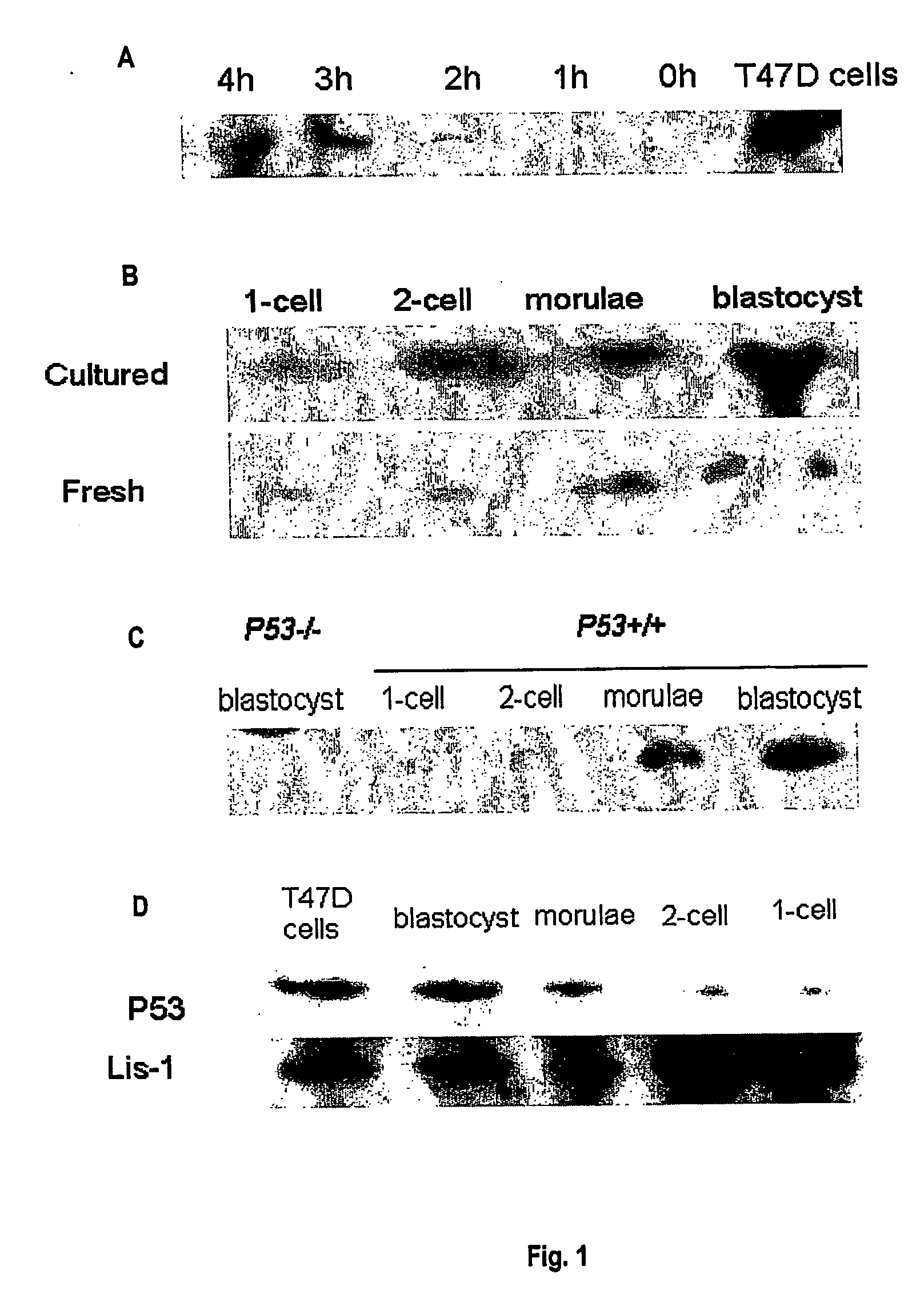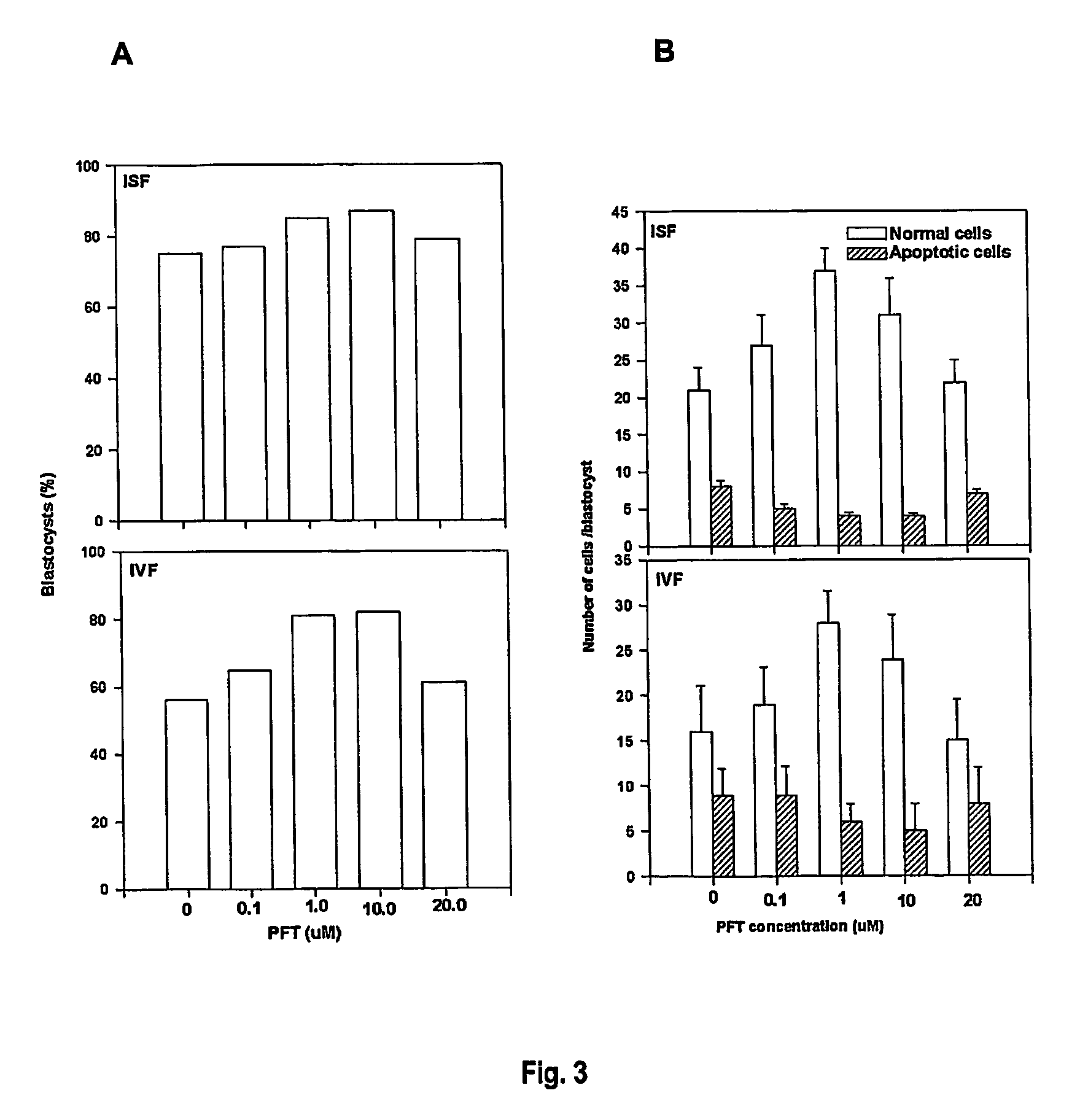Methods for enhancing embryo viability
a technology of viability and composition, applied in the field of methods and compositions for enhancing the viability of embryos, can solve the problems of failure to survive the embryo, degeneration of the entire embryo, and failure to treat the various stressors with only limited success
- Summary
- Abstract
- Description
- Claims
- Application Information
AI Technical Summary
Benefits of technology
Problems solved by technology
Method used
Image
Examples
example 1
p53 Expression in Mouse Embryos
Example 1(A)
[0164] RT-PCR was used to compare the expression of p53 mRNA in fresh p53+ / +mouse embryos (embryos fertilised and grown in the reproductive tract) and IVF mouse embryos. For IVF embryos, the model uses a graded range of stress induced by IVF and culture under conditions of increasing growth factor deprivation. Primers were designed (5′-GGA GTC TTC CAG TGT GAT GAT, 3′-GGG ACA GCC MG TCT GTT ATG) that successfully produced an RT-PCR product of the correct size (429 bp) and sequence (SUPAMAC) for the p53 gene. Groups of 5 embryos, oocytes or sperm were pooled. mRNA was extracted and RT-PCR performed.
[0165] p53 product was detected in oocytes, zygotes, 8-cell, morulae and blastocyst stage mouse embryos collected from the reproductive tract but not in epididymal sperm. In 2-cell embryos detection was variable. Incubation of zygotes in the transcription inhibitor α-amanitin had no effect on qualitative expression of p53 RNA in ...
example 1 (
Example 1(B)
Protein Expression
[0166] F1 (C57BL / 6j×CBA / J), C57B16j and p53− / − embryos or sperm were used to examine p53 protein expression levels. T47D breast cell line was used as a positive control for the detection of p53. Four to eight week old females were superovulated by i.p. injection of 10 IU pregnant mare serum gonadotrophin (Folligon, Intervet International, Boxmeer, The Netherlands) followed 48 h later by 10 IU human chorionic gonadotrophin (hCG, Chorulon, Intervet). Females were either left unmated or paired with males of proven fertility. Day 1 of pregnancy was confirmed by the presence of a copulation plug the following morning.
[0167] Mice were killed by cervical dislocation. Cumulus masses or embryos were flushed from the reproductive tract with Hepes-buffered human tubal fluid medium with 3 mg BSA / ml (Hepes-HTF-101.6 mM NaCl, 4.69 mM KCl, 0.2 mM MgSO4, 0.37 mM KH2PO4, 21.4 mM Na lactate, 2.78 mM glucose, 2.04 mM CaCl2, 5 mM NaHCO3, 0.33 mM Na pyr...
example 2
Immunolocalisation of p53 in Mouse Embryos
[0172] The expression pattern of p53 protein in pre-implantation mouse embryos was investigated using immunofluorescence.
[0173] Embryos were washed 3-times (washing media: PBS with 0.1% BSA, 0.1% Tween-20) and fixed with fresh 2% paraformaldehyde (Sigma) in PBS PH 7.4 for 1 h at room temperature. Embryos were permeabilised for 30 min at room temperature in PBS with 2% BSA, 0.2% Tween-20 and 0.2% Triton X-100 and blocked in 2% BSA and 30% blocking serum for 1-3 h. p53 antigen was stained overnight at 4° C. with 2 μg anti-p53 sheep polyclonal antibody / ml (Oncogene Research Products (PC35) or rabbit polyclonal anti-Bax (Santa-Cruz Biotechnology, N-20) in PBS with 2% BSA and then 5 μg rabbit anti-sheep FITC conjugated antibody / ml for 1 h at room temperature (green channel). Controls were 2 μg non-immune IgG / ml instead of primary antibody. Immunofluorescence images were observed using a BioRad Radiance confocal microscope (Australian Key Centre...
PUM
| Property | Measurement | Unit |
|---|---|---|
| volume | aaaaa | aaaaa |
| pH | aaaaa | aaaaa |
| concentration | aaaaa | aaaaa |
Abstract
Description
Claims
Application Information
 Login to View More
Login to View More - R&D
- Intellectual Property
- Life Sciences
- Materials
- Tech Scout
- Unparalleled Data Quality
- Higher Quality Content
- 60% Fewer Hallucinations
Browse by: Latest US Patents, China's latest patents, Technical Efficacy Thesaurus, Application Domain, Technology Topic, Popular Technical Reports.
© 2025 PatSnap. All rights reserved.Legal|Privacy policy|Modern Slavery Act Transparency Statement|Sitemap|About US| Contact US: help@patsnap.com



